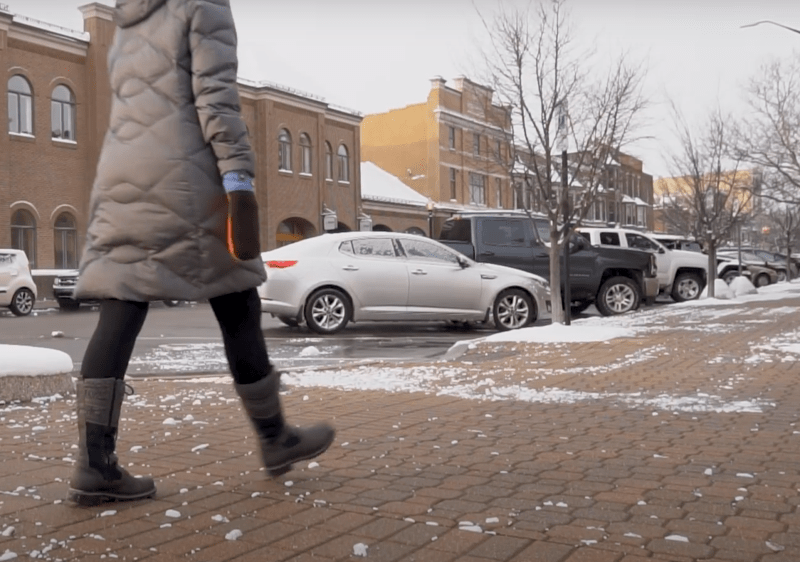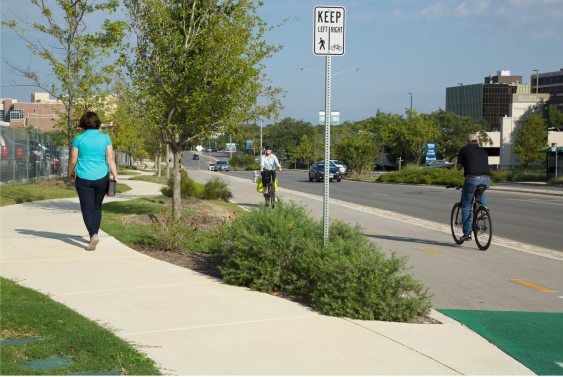Holland has a long history of going above and beyond for people who travel outside cars in the winter — and no, we're not talking about that Holland.
The small, snowy city of Holland, Mich. recently captured the attention of active transportation advocates, thanks to a viral video of one of its sidewalk snow plows zipping down a residential street. That mini-plow is just one of a fleet of five machines, and together, they can clear almost all of the the city's 140 miles of sidewalks in just eight hours.
"It has overwhelming support, not just from residents but from the business community," said Andy Kenyon, parks and recreation director for the city. "Our community schools rely on it, and so do a lot of workers. It's definitely a community value to keep the sidewalks clear."
Holland still has a sidewalk clearing ordinance on the books that requires property owners to tidy up any snow adjacent to their properties that the mini-plows might have missed. But the city still undoubtedly goes farther than most local governments in the U.S., the best of which only clear sidewalks after driving lanes have been fully treated first, or only after particularly bad storms. The west Michigan beach town plows nearly every inch of its sidewalk network at the same time other crews are clearing the larger roadways, and has even updated its equipment several times in the last 40 years, trading plows attached to small pick-up trucks for dedicated Bombadier-branded vehicles.
And sidewalk clearance is just the tip of the iceberg when it comes Holland's support of vulnerable road users. The city is also famous for being the home of North America's largest snowmelt system, which diverts 95-degree water away from the cooling towers of a nearby power plant and into a 190-mile tubing system that heats most of the downtown's roads and sidewalks from below, melting as much as one inch of snow every hour.
The snowmelt system began as part of the city's efforts to keep the downtown core strong when the rise of the shopping malls threatened the local retail ecosystem in the late 1980s. Wealthy local industrialist Ed Prince had seen the idea implemented at a smaller scale during his travels in Europe, and built up a coalition of local business and government leaders to support the installation of a snowmelt system in his hometown, contributing $250,000 of his own money to help fund the first three blocks in the network in 1988.
Over the last 30+ years, the city has gradually expanded the snow melt system to cover nearly the entire downtown core and several key routes beyond it – and a recent renovation at the power plant means that they now have the capacity to eventually expand it up to five times its current size. Today, an impressive 4.9 miles of Holland's roads are continuously heated, including the sidewalks outside key city buildings like the city hall and civic center, which locals say makes government services more accessible to people in wheelchairs and on foot. A recent extension connecting the sidewalks between a local senior living community to the downtown core has proven particularly popular.
"You see people out there with walkers and wheelchairs every day now, year round," Kenyon adds. "It’s a tremendous thing, and we’re spoiled to death to have it."
Holland's efforts to support multi-modal road users in the winter might seem like a luxury — at least when compared to the vast majority of snowy communities in the United States, which all but abandon their walkers to the elements and trust individual property owners to pick up the slack. But from a fiscal perspective, it's a frugal move.
The snowmelt system costs about $57,000 a year to operate and maintain, most of which is paid for by taxes on local businesses who benefit from year-round foot-traffic; the city also saves on road salt, the replacement costs of weather-beaten pavement, and reduced liability for slip-and-falls. The money to plow the sidewalks comes out of the city's general fund — just like the money the city spends to plow the larger road — but Kenyon says that investing in comfortable, green travel has still paid off for the city. Holland is a big part of why surrounding Ottawa County is among the fastest-growing counties in Michigan, and it's been ranked by Forbes, the National Civic League, and the Gallup-Healthways Wellbeing Index as among the healthiest and happiest places to live in America, among others — a rare feat for a city that gets 70 inches of snow a year, with a population of just 33,000 and a median income that's slightly lower than the state average.
Kenyon recognizes that prioritizing the needs of non-drivers isn't always financially or politically easy, especially now that COVID-19 has battered municipal budgets. But he also says that cities of any size can do more to support people who walk and roll outside private vehicles.
"It’s not free and it’s not cheap, but you also don’t have to bite it off all at once," Kenyon says. "Start small and expand it out. Find a piece of used sidewalk-clearing equipment or two. Find a few routes where a lot of people walk or congregate regularly. Start somewhere."






